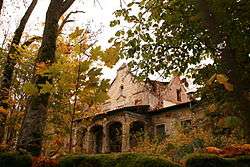Sēja Manor
Sēja Manor (Latvian: Sēja muiža; German: Zögenhof) was a knight's manor in the Krimulda Parish in the Riga county of Livonia.[1]

.jpg)
| Sēja Manor | |
|---|---|
.png) Sēja Manor house (German: Zögenhof) in 1905. | |
 Sēja manor Location within Latvia | |
| General information | |
| Architectural style | ruins |
| Town or city | Sēja Municipality, |
| Country | Latvia |
| Coordinates | 57°11′54.5″N 24°35′28.8″E |
| Completed | 1766, rebuilt in 1883—1885 |
History
In 1567 the manor was acquired by Johan Seyge (Zöge). The Latvian name of Sēja manor comes from the landlord's surname. The present ruined manor house was first built in 1766. From 1751 until the Latvian agrarian reform in 1920s the manor belonged to the noble Dunten family, which was related to the famous Münchhausen family. Hieronymus Carl Friedrich von Münchhausen spent several years in Livonia and in 1744 married Jacobine von Dunten, daughter of baron von Dunten.[3] In 1883–1885 manor house was rebuilt, the sophisticated neo-Gothic decorations has been added to a modest mansion.[1]
After state of Latvia confiscated manor from von Dunten family property was divided into smaller land lots and in manor house a club was established. In soviet Latvia from 1963 to 1968, the manor house hosted club of the collective farm "Komuārs" and also library operated there. Presently building is severely dilapidated and in state of ruins. [1]
Besides main manor house property also has a granary and a water tower.
Archeology
Artifacts from ancient stone box grave culture has been found on Sēja Manor land.[4]
References
- (in Latvian) Sējas pils (drupas)
- Excerpt from the map Wegekarte des Rigaschen Kreises mit den Kirchspiels- und Gutsgrenzen (1905).
- Jacobine von Dunten
- (in German) Jakob Ozols Die baltische Steinkistengräberkultur, Volume 16 of Vorgeschichtliche Forschungen. Publisher De Gruyter, 219 pages 1969
